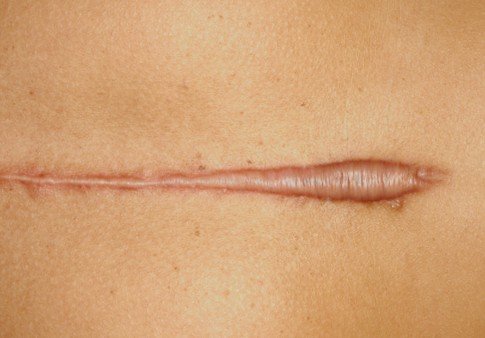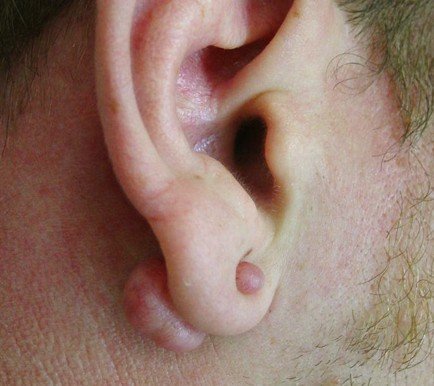Keloid
Last reviewed by Dr. Raj MD on January 12th, 2022.
What is a Keloid?
This is a scar that grows out of control and keeps growing until it protrudes beyond the boundaries of your original wound. They are often referred to as keloid scars or hypertrophic scars. They can appear at any stage during the healing of a wound, even a wound that is perfectly cared for. They can grow on any part of your body and can grow slowly or quickly. They can happen to anyone regardless of age, although they are more common in people ages ten to twenty, or gender. It can happen to all races but it seems that people who are Asians, Hispanics, and African Americans who have darker skin are more likely to develop them. They can grow on any type of wound from an old pimple to a wound from recent surgery. A keloid will generally not cause any further damage or injury and are considered benign, which means they are not cancerous.
Keloid Symptoms
- They are raised, dome shaped and appears shiny, or ridged or lumpy.
- Can range in color from pink to red to purplish
- Some can be very large and unsightly
- Can itch
- Can be painful to the touch
- Can be tender
- Can be irritated from friction such as being rubbed on clothing.
For the first year after it is formed it will tan darker around the skin when exposed to the sun. The darker color may or may not go away.
Keloid Causes
It is caused by an increased formation of tissue after some type of trauma to your skin. When your skin is healing from this trauma there can be an overproduction of collagen, which is a type of protein that is fibrous in nature and supports and connects other body tissues like your bones, muscles, tendons, and skin. This collagen covers the area that is injured. When you have an overproduction of collagen built up it can form an unsightly purplish or red mass. Keloid scarring is genetic so if there are other family members that have keloids are more susceptible to having them too.
Other causes can be from:
- Acne
- Burns
- Chickenpox
- Ear piercing
- Scratches that are minor
- Cuts from trauma or surgery
- Sites where you have received vaccinations
Treatment
Many times a keloid will not need any type of treatment but if they are unsightly or causing any pain there are ways that you can treat them, including removing them. Because they can return even after treatment sometimes it is best to just not treat them at all.
Steroid treatments
One way to treat them is for your healthcare provider, whether it is your physician or dermatologist, can inject steroid medication into the skin that is around the keloid. In many cases this has been a successful treatment but do not work for everyone. This is the treatment that best used on smaller scars. If you have dark skin using this treatment can cause you to lose skin pigmentation, or color. This treatment will also require you to have multiple injections so you will have to visit your healthcare provider several times. Two of the steroids used in these injections are triamcinolone or hydrocortisone but there are others. You will get an injection every fourteen to twenty-one days.
Other medical treatments
Some health care providers like to use other treatment such as cryosurgery. With this form of treatment they will apply liquid nitrogen to the keloid so it will destroy any abnormal tissue. It is also not unusual with this form of treatment that the keloid will grow back eventually. It could come back darker in color. Laser treatment has also been used to decrease the size of the keloid along with improving its color. You can also have interferon protein injections to shrink the scar. Any of these methods have shown some type of promise to be a good treatment but there is still not enough data to know if they do or do not work. One big drawback is that medical insurance is not likely to cover the treatments. How much it would cost to use any of these treatments would depend on the size of the keloid, where it is located, and the type of treatment that you are going to use. It can cost from a few hundred dollars to several thousand, including the health care provider fee. That is a lot of money to pay for treatment in which the keloid is most likely to come back.
Homeopathic treatments
You can try homeopathic treatments like applying topically compounds that are rich in vitamin E or tea tree oil. It is also said that using compression or silicone bandages can help reduce the size of the keloid but most likely not get rid of them.
Removal
There are also many different ways in which you can remove a keloid.
Radiation therapy and surgery
The removal of the keloid is called excision and is done under local anesthetic with a scalpel. Unfortunately removing a keloid does not always work. There have even been some cases the keloid has even grown back and if this happens there is a chance it will look worse that it originally did. Surgically removing the keloid alone has an average success rate of sixty-five percent. In order to make the success rate you can also have radiation therapy done as a last resort. In many cases if you treat the area with a radiation beam after the surgery has been done it will damage the cells which will help to prevent another keloid from forming. Using radiation therapy is normally only done when the keloid is disfiguring and is very resistant to any other form of treatment. Before using radiation therapy you need to consider that there is an additional risk of getting cancer.




